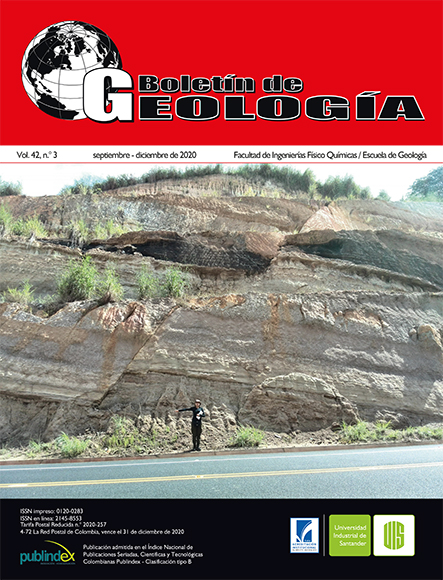Porosity prediction from X-ray computed tomography logs (RHOB and PEF) using Artificial Neural Networks (ANN)
Published 2020-09-30
Keywords
- CT,
- Rock images,
- Well logs,
- High-resolution logs,
- Artificial Intelligence
How to Cite
Copyright (c) 2020 Boletín de Geología

This work is licensed under a Creative Commons Attribution 4.0 International License.
Altmetrics
Abstract
This work presents a method for rock porosity prediction from the X-ray computed tomography (CT) logs obtained using a double energy approach, bulk density (RHOB) and photoelectric factor (PEF). The proposed method seeks to correlate the known porosity from the Routine Core Analysis (RCAL) with RHOB and PEF high-resolution logs, as the response of these two measurements depends on the volumetric quantity of different rock materials and of the volume of its porous space. Artificial Neural Networks (ANNs) are trained so they can predict porosity from CT logs at a high resolution (0.625 mm). The ANNs validation and regression plots show that porosity predictions are good. High-resolution porosity models linked to CT images could contribute to enhancing the petrophysics model as they allow a more refined identification of intervals of interest due to the detailed measurement.
Downloads
References
Akin, S.; Schembre, J.; Bhat, S.; Kovscek, A. (2000). Spontaneous imbibition characteristics of diatomite. Journal of Petroleum Science and Engineering, 25(3-4), 149-165. https://doi.org/10.1016/S0920-4105(00)00010-3
Akin, S.; Kovscek, A. (2003). Computed tomography in petroleum engineering research. Geological Society, London, Special Publications, 215, 23-38.
https://doi.org/10.1144/GSL.SP.2003.215.01.03
Al-Bulushi, N.; Araujo, M.; Kraaijveld, M.; Jing, X. (2007). Predicting water saturation using Artificial Neural Networks (ANNs). 1st Annual SPWLA Middle East Regional Symposium, Abu Dhabi, United Arab Emirates.
Calzado, A.; Geleijns, J. (2010). Tomografía computarizada. Evolución, principios técnicos y aplicaciones. Revista de Física Médica, 11(3), 163-180.
Funk, J.J.; Withjack, E.M.; Siddiqui, S.; Al-Enezi, S.M.; Caliskan, S. (2011). Core imaging - twenty five years of equipment, techniques, and applications of X-ray computed tomography (CT) for core analysis. International Symposium of the Society of Core Analysts. Austin, Texas, USA.
Kantzas, A.; Marentette, D.; Jhan, K.N.N. (1992). Computer-assited tomography: from qualitative visualization to quantitative core analysis. Journal of Canadian Petroleoum Technology, 31(9), 48-56. https://doi.org/10.2118/92-09-06
Konaté, A.A.; Pan, H.; Khan, N.; Ziggah, Y.Y. (2015). Prediction of porosity in crystalline rocks using artificial neural networks: an example from the Chinese Continental Scientific Drilling Main hole. Studia Geophysica et Geodaetica, 59(1), 113-136. https://doi.org/10.1007/s11200-013-0993-5
Larmagnat, S.; Des Roches, M.; Daigle, L.F.; Francus, P.; Lavoie, D.; Raymond, J.; Malo, M.; Aubiès-Trouilh, A. (2019). Continuous porosity characterization: Metric-scale intervals in heterogeneous sedimentary rocks using medical CT-scanner. Marine and Petroleum Geology, 109, 361-380. https://doi.org/10.1016/j.marpetgeo.2019.04.039
Ortiz-Meneses, A.F.; Plata-Chaves, J.M.; Herrera-Otero, E.; Santos-Santos, N. (2015). Caracterización estática de rocas por medio de tomografía computarizada de rayos-X TAC. Revista Fuentes: El Reventón Energético, 13(1), 57-63. https://doi.org/10.18273/revfue.v13n1-2015005
Siddiqui, S.; Khamees, A. (2004). Dual-energy CTscanning applications in rock characterization. SPE Annual Technical Conference and Exhibition. Houston, Texas, USA. https://doi.org/10.2118/90520-MS
Singh, S.; Kanli, A.; Sevgen, S. (2016). A general approach for porosity estimation using artificial neural network method: a case study from Kansas gas field. Studia Geophysica et Geodaetica, 60(1), 130-140. https://doi.org/10.1007/s11200-015-0820-2
Sun, Q.; Eissa, M.; Castagna, J.; Cersosimo, D.; Sun, S.; Decker, C. (2001). Porosity from artificial neural network inversion for Bermejo Field, Ecuador. SEG Int’l Exposition and Annual Meeting. San Antonio, Texas, USA.
White, A.C.; Molnar, D.; Aminian, K.; Mohaghegh, S.; Ameri, S.; Esposito, P. (1995). The application of ANN for zone identification in a complex reservoir. SPE Eastern Regional Conference & Exhibition. Morgantown, West Virginia, U.S.A.
Withjack, E.M.; Devier, C.; Michael, G. (2003). The role of x-ray computed tomography in core analysis. SPE Western Regional/AAPG Pacific Section Joint Meeting. Long Beach, California, USA.

